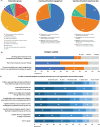Co-creation of the Global Patient Experience Data Navigator: a multi-stakeholder initiative to ensure the patient voice is represented in health decision-making
- PMID: 37828617
- PMCID: PMC10571339
- DOI: 10.1186/s40900-023-00503-9
Co-creation of the Global Patient Experience Data Navigator: a multi-stakeholder initiative to ensure the patient voice is represented in health decision-making
Abstract
Background: Putting patients' needs and priorities at the forefront of healthcare initiatives and medical product development is critical to achieve outcomes that matter most to patients. This relies on the integration of early, meaningful patient engagement (PE) to learn what is important to patients, and collection of representative patient experience data (PXD). The increased number of PE/PXD efforts across global regulatory, health technology assessment, and healthcare systems is an important step forward to deliver improved health outcomes for patients. However, these initiatives are fragmented and lack integration, which is necessary to maximize efforts and reduce burden on patients. To overcome these challenges, the Global Patient Experience Data Navigator has been co-created by Patient Focused Medicines Development to provide practical resources that can facilitate and optimize PXD generation, collection, analysis, and dissemination for patient benefit and aims to be applicable across all therapeutic areas for all stakeholders.
Methods: Co-creation of the Navigator took place through an iterative process of validation and formalization driven by a diverse, multi-stakeholder working group with individuals who have varying knowledge/experience in PE/PXD.
Results: A series of workshops took place to conduct a gap analysis, develop a taxonomy model, and integrate existing frameworks. The collective insights led to the development of the Navigator consisting of four specific tools in the form of downloadable templates, which can be used to: (1) prioritize outcomes that matter most to patients and their caregivers; (2) select appropriate measurement methods for these outcomes; (3) identify when and why PXD is used throughout the product development cycle for each stakeholder; (4) identify when and why PXD is used throughout the healthcare process for each stakeholder. A public consultation was carried out to collect user feedback before the Navigator was made publicly available in December 2022.
Conclusion: To our knowledge, the Global Patient Experience Data Navigator is the only publicly available toolkit developed with a multi-stakeholder and disease-agnostic approach providing taxonomically grouped resources to optimize the collection and collation of PXD for patient benefit. Future work will aim to further engage patients by adding a PE dimension to the Navigator.
Keywords: Healthcare; Medical, pharmaceutical, and technology development; Patient engagement; Patient experience data; Patient-centered care; Patient-generated data; Patient-preference studies; Patient-reported outcomes; Public and patient involvement.
Plain language summary
Engaging patients at the start of healthcare and medical product development projects can help better understand their experiences and what is most important to them. Ultimately this will achieve the best outcomes. However, if not carefully planned, projects that engage patients can lead to inefficiencies, such as patients being asked for the same information repeatedly. The collection of patient experience data—information related to patients’ experiences, needs, and priorities—also needs to be carefully managed. To help solve this problem, Patient Focused Medicines Development developed a publicly available “toolkit” called the Global Patient Experience Data Navigator. The Navigator has downloadable templates that can be filled in and used for projects in any disease area and by anyone collecting patient experience data. To represent different perspectives, individuals with a range of experiences and understanding of patient engagement projects worked together to co-create the toolkit. Several meetings took place to understand what the toolkit needed to do and to help provide a structure for the templates. There are four templates in the toolkit. These can be used to: (1) prioritize outcomes that matter most to patients and their caregivers; (2) select the best ways of measuring these outcomes; (3) identify when, why, and by whom patient experience data is used throughout the product development cycle; and (4) identify when, why and by whom patient experience data is used throughout the healthcare process. Future work will utilize public feedback to make the toolkit more user-friendly and provide education on how the Navigator can be used.
© 2023. BioMed Central Ltd., part of Springer Nature.
Conflict of interest statement
EO is employed by Applied Patient Experience, LLC, which has contracts with a variety of non-profit organizations, pharmaceutical companies, and academic institutions. OAE is the Senior Vice President, Equity, Research and Programs at the National Health Council, a non-profit, membership organization that receives dues, sponsorships, and grants; a complete list of members, sponsors, and funders is available on the National Health Council website. However, both EO and OAE declare they have no conflicts of interest with this work and that none of the activities or sponsorship listed would have influenced the work reported. All other authors declare that they have no known competing financial interests or personal relationships that could have influenced the work reported in this article.
Figures





References
-
- World Health Organisation. WHO global strategy on people-centred and integrated health services: Interim Report, 2015. https://apps.who.int/iris/bitstream/handle/10665/155002/WHO_HIS_SDS_2015.... Accessed 17 Jan 2023.
LinkOut - more resources
Full Text Sources
Miscellaneous

